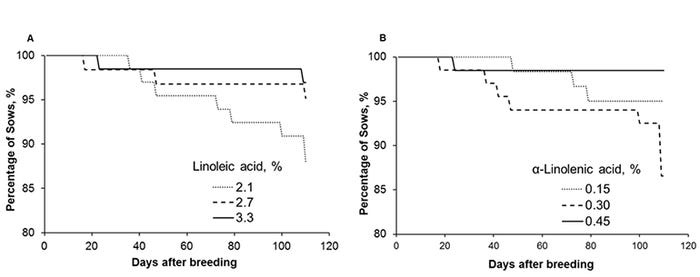Essential fatty acids promote reproduction in high-producing sows
Study was conducted to define the minimum levels of essential fatty acids required by the prolific and high-producing sow for optimal subsequent reproduction.
February 8, 2018

By Eric van Heugten, North Carolina State University; David Rosero, The Hanor Co.; and R. Dean Boyd, North Carolina State University and The Hanor Co.
The nutritional requirements of high-producing, modern lactating sows have increased substantially because of genetic improvements for litter size. For larger and rapid-growing litters the demand for milk production has increased dramatically, as the modern sow needs to produce nearly 10 kilograms of milk per day, which is much greater than the standard sow of the past, producing approximately 7.5 kilograms per day.
Nevertheless, the development of the modern lactating sow has also resulted in an animal with less body fat reserves and lower appetite. Ensuring the optimal nutrition of the high-producing sow becomes particularly important to maximize lactation output and long-term productivity. Limitation of energy and nutrient intake is challenging for the sow, resulting in the mobilization of body reserves to replace the nutrient deficiency. This is especially the case during heat stress in which sows dramatically reduce their nutrient intake.
In addition, exposure of sows to high ambient temperatures results in physiologic and metabolic changes that can lead to impaired intestinal barrier function and increased oxidative stress. Supplemental lipids are of particular importance in sow nutrition programs due to the higher energy density and lower heat increment associated with digestion and metabolism when compared to carbohydrates, fibers and proteins. Although, supplemental lipids are extensively used in sow lactation diets as concentrated sources of energy, their nutritional value is not limited to energy as lipids are also important sources of essential fatty acids (linoleic acid, C18:2n-6; and α-linolenic acid, C18:3n-3).
In our previous research we demonstrated that lactating sows fed diets without supplemental lipids had poor subsequent reproduction (farrowing rate of less than 72%) and that this was remarkably improved by the inclusion of only 2% supplemental lipid to lactation diets. Based on the fatty acid concentrations in milk samples from sows, we calculated that the supplementation of at least 2% lipids provided the required levels of linoleic acid to sows. We hypothesized that the benefits observed on subsequent reproduction in previous studies were due to the provision of EFA (especially linoleic acid) from addition of lipids to diets.
We conducted the next study to define the minimum levels of EFA required by the prolific and high-producing sow for optimal subsequent reproduction. A total of 480 lactating sows (equally balanced by Parity 1, and 3 to 5, P3+) were assigned randomly to a 3 x 3 factorial arrangement plus a control diet without added lipid (the control diet contained 1.3% linoleic acid and 0.07% α-linolenic acid). Factors included linoleic (2.1, 2.7 and 3.3%) and α-linolenic acid (0.15, 0.30 and 0.45%), obtained by adding 4% of mixtures of canola, corn and flaxseed oils to diets.
Sows that were fed lactation diets containing lows levels of EFA (< 2.7% linoleic acid and < 0.45% α-linolenic acid) had reduced subsequent farrowing rate (75%) and elevated culling rate (25%). It is possible that these sows were under a negative EFA balance during lactation. Under these conditions, supplementation of ≥ 2.7% linoleic or 0.45% α-linolenic acid improved the subsequent farrowing rate and reduced the culling rate (Figure 1).

Figure 1: Effects of supplemental EFA during lactation on the subsequent farrowing rate (percentage of sows that farrowed in the subsequent cycle) of mature sows (P3+). Bars represent sows that had a negative EFA balance (control diet without supplemental lipid and diets containing < 2.7% linoleic acid and < 0.45% α-linolenic acid) or a positive EFA balance (≥ 2.7% linoleic acid and 0.45% α-linolenic acid) during lactation. Means represented by bars without a common letter are different (P ≤ 0.10).
The improvements in farrowing rate were related to a reduced number of sows showing irregular returns (> 24 days after breeding). Apparently, sows fed adequate amounts of linoleic acid (> 2.1%; Figure 2A) or α-linolenic acid (0.45%; Figure 2B) were able to maintain pregnancy. In addition, supplemental linoleic acid (linear, P = 0.07; 13.15, 13.85 and 13.99 total pigs born and 12.49, 13.15 and 13.24 pigs born alive for 2.1, 2.7 and 3.3% linoleic acid, respectively), but not α-linolenic acid (P = 0.706), increased the subsequent litter size of Parity 1 and P3+ sows.

Figure 2: Effects of supplemental (A) linoleic and (B) α-linolenic acid during lactation on the capacity of mature sows (P3+) to maintain pregnancy in the subsequent cycle. Lines represent the percentage of pregnant sows after breeding (n = 60-67 bred sows).
Results of this work demonstrate that EFA supplementation during lactation directly affects subsequent reproduction and that this phenomenon is increasingly important with advancing sow age. Another significant finding was the fact that α-linolenic acid seemed to compensate for a deficiency of linoleic acid. We conclude that a minimum dietary intake of 10 grams per day of α-linolenic acid, together with a minimum of 125 grams per day of linoleic acid should be provided to at least 95% of the sows to achieve maximum sow reproductive efficiency through multiple mechanisms that include rapid return to estrus, high maintenance of pregnancy and large subsequent litter size in mature sows, that appear to be susceptible to EFA deficiency.
You May Also Like



